| |
Examination of factors influencing response to darunavir combined with low-dose ritonavir in POWER 1, 2, and 3: Pooled 48-week analysis
|
| |
| |
".....there is a greater probability of virologic success when there are additional active agents in the OBR...see Table 3)
Reported by Jules Levin
Presented at HIV-DART, Frontiers in Drug Development for Antiretroviral Therapies, 10-14 December 2006, Cancun, Mexico
J Gathe, Jr.1; E deJesus2; R Falcon3; SS Guzman4; and T Vangeneugden4
1Therapeutic Concepts, Houston, TX, USA; 2xLeo, Inc., Raleigh, NC, USA; 3Tibotec Therapeutics, Bridgewater, NJ, USA; and 4Tibotec BVBA, Mechelen, Belgium
AUTHOR CONCLUSIONS
DRV/r 600/100mg bid provided a strong and durable response throughWeek 48 in the POWER trials.
DRV demonstrated a high genetic barrier to resistance:
- 79% of patients achieving ≥1 log10 VL reduction but who had VL ≥50 copies/mL at Week 24 maintained or improved their response throughWeek 48.
Baseline FC to DRV and baseline number of DRV-associated mutations are strong predictors of response, with DRV FC ≦10 and ≦2 DRV-associated mutations predicting the best virologic response.
Virologic response increased as additional active agents were used with DRV/r.
Abstract
Background: Factors influencing the efficacy of darunavir (DRV; TMC114 [PREZISTA]) with low-dose ritonavir (DRV/r) in treatment-experienced patients with HIV were evaluated, utilizing pooled 48-week data from POWER 1, 2, and 3.
Methods: All patients (N=458) who initiated treatment with DRV/r 600/100mg bid in the three POWER trials (randomized, controlled POWER 1 and 2 [TMC114-C213 and C202] and open-label, roll-over POWER 3 [TMC114-C215/C208]) were included in the analysis. Based on similarities between the trials in patient
baseline disease characteristics, DRV/r dosing, inclusion/exclusion criteria, and efficacy and safety outcomes, data were pooled to better evaluate factors contributing to the efficacy of DRV/r in HIV-infected, treatment-experienced patients.
All patients received DRV/r 600/100mg bid plus an optimized background regimen (OBR) of ≥2 NRTIs ± enfuvirtide (ENF).Week 48 efficacy was analyzed by baseline phenotypic fold change (FC) in EC50 to DRV, the number of primary IAS-USA protease inhibitor (PI) resistance-associated mutations, number of DRV-associated mutations, number of active agents in OBR, and the relative
contribution of ENF by DRV-associated mutation cohort.
Results:
At baseline, mean VL was 4.6 log10 copies/mL, 70% of patients had a FC (fold-change) to DRV ≦10, and 75% had ≦2 DRV-associated mutations. The median number of IAS-USA primary PI mutations was 3.
At Week 48, ≥1 log10 reduction in HIV RNA and HIV RNA <50 copies/mL (undetectable VL) were achieved by 62% and 45% of patients in pooled POWER 1 and 2, and by 61% and 45% of patients in POWER 3.
Undetectable VL at Week 48 was achieved by 54%, 28% and 14%, respectively, of patients with FC ≦10, FC >10-40 and FC >40 at baseline; by 53% and 20%, respectively, of patients with ≦2 DRV-associated mutations and ≥3 DRV-associated mutations; and by 54% of patients with ≥2 active ARVs in the OBR.
In patients with ≦1 DRV-associated mutation at baseline, the contribution of ENF was incremental; at Week 48, 62% and 64% of patients who used ENF naively or did not use ENF achieved undetectable VL, respectively. Patients not receiving ENF had a higher mean CD4 count and more active NRTIs in their OBR at baseline (198 vs 112 cells/mm3, respectively, and 41% vs 22% of patients with ≥2 active NRTIs).
The benefit of adding ENF was more evident in patients with 2 DRV-associated mutations (undetectable VL was achieved by 62% and 40% of patients who used ENF naively or did not use ENF, respectively) and ≥3 DRV-associated mutations
(43% and 14%, respectively).
Conclusion: Baseline FC to DRV ≦10 and presence of ≦2 DRV-associated mutations at baseline were the best predictors of virologic response to DRV/r 600/100mg bid. Virologic response increased as additional active agents were used with DRV/r.
Introduction
Darunavir (DRV; TMC114 [PREZISTA]) is a highly active HIV protease inhibitor (PI) that exhibits potent in vitro activity against both wild-type and resistant HIV strains, including multi-drug resistant strains.1
DRV is currently approved in the US, Canada, Russia, and Argentina with low dose ritonavir at a recommended dose of 600/100mg bid for the treatment of HIV infection in antiretroviral treatment-experienced adult patients.
The International AIDS-Society Panel 2006 recommends that the virologic target for treatment-experienced patients should be a plasma viral load (VL) <50 copies/mL,2 and the current DHHS Guidelines for the Use of Antiretrovirals in HIV-1 Infected Adults and Adolescents recommend re-establishing maximal virologic suppression in these patients.3
- The proportion of patients who reached VL <50 copies/mL atWeek 48 in the POWER 1, 2, and 3 (DRV),4,5 RESIST 1 and 2 (tipranavir)6 and TORO 1 and 2 (enfuvirtide)7 trials was 45%, 21%, and 18%, respectively (Figure 1).
POWER 1 and 2 (TMC114-C213 and TMC114-C202) were Phase IIb randomized, controlled, multi-center trials designed to investigate the efficacy and safety of DRV administered with low-dose ritonavir (DRV/r) at four different doses compared with control PIs (CPI[s]) in treatment-experienced HIV-infected patients.
To further define the safety and efficacy of DRV/r 600/100mg bid in treatment-experienced patients, 327 patients were enrolled in a large, open-label analysis (POWER 3; TMC114-C215 and TMC114-C208).
We present a pooled 48-week analysis of the DRV/r 600/100mg bid dose in POWER 1, 2, and 3. The rationale for pooling the data from these trials was based on similarities between patient baseline disease characteristics, DRV/r dosing, inclusion/exclusion criteria, and efficacy and safety outcomes across the 3 trials.8-11
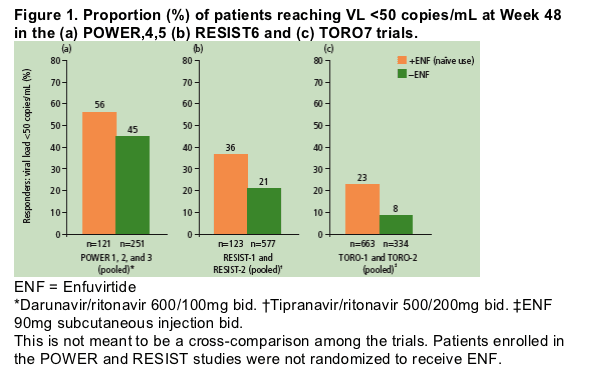
Methods
This was a combined analysis atWeek 48 of POWER 1, 2, and 3 (Figure 2).
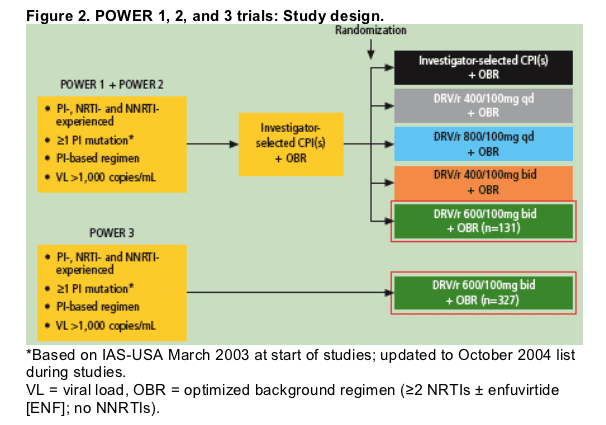
Primary inclusion criteria for patients were as follows:
- HIV RNA >1,000 copies/mL.
- ≥3 months prior treatment with ≥2 NRTIs and ≥1 NNRTI in a failing regimen.
- ≥1 PI treatment received for ≥3 months.
- ≥1 primary PI resistance-associated mutation (based on the 2003 IAS-USA guidelines12 and updated in 200413 to include D30N, L33F/I, M46I/L, G48V, I50L/V, V82A/F/L/S/T, I84A/C/V, and L90M).
Investigators selected an optimized background regimen (OBR) based on genotypic resistance testing (VirtualPhenotypefrom Virco) and prior antiretroviral (ARV) history, which consisted of two or more NRTIs with or without enfuvirtide (ENF), and excluded NNRTIs.
Week 48 efficacy data were analyzed according to:
- Baseline phenotypic fold change in EC50 (FC) to DRV.
- Number of DRV-associated mutations at baseline (V11I, V32I, L33F, I47V, I50V, I54L or M, G73S, L76V, I84V, and L89V).14
- Number of active antiretroviral (ARV) drugs in the OBR.
- Relative contribution of ENF by DRV-associated mutation cohort (excluding patients who recycled ENF).
Results
Of 458 patients receiving DRV/r 600/100mg bid in the POWER trials, 455 had completed through Week 48 or discontinued earlier at the time of analysis.
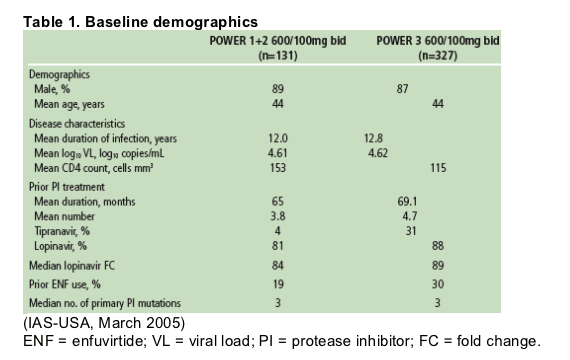
Median baseline FC to DRV was 3.5, 4.9, and 3.2 in POWER 1, 2, and 3, respectively; 70% of patients had a FC ≦10, 17% had FC >10-40, and 13% had FC >40.
Virologic response to DRV/r is shown in Figure 3.
Most patients (92%) who achieved HIV RNA <50 copies/mL atWeek 24 remained undetectable at Week 48 in POWER 1, 2, and 3 (Figure 4).
Of 112 patients who achieved ≥1 log10 reduction in HIV RNA but did not achieve full virologic suppression to <50 copies/mL atWeek 24, 60% maintained this response and 19% achieved VL <50 copies/mL atWeek 48 (Figure 4).
Mean increase in CD4 count atWeek 48 was 102 cells/mm3 in pooled POWER 1 and 2, and 107 cells/mm3 in POWER 3.
DRV/r was generally safe and well tolerated; the majority of adverse events (AEs) were mild to moderate (Grade 1 or 2) in severity.
Impact of baseline FC to DRV on virologic response
Baseline phenotypic FC to DRV was a strong predictor of virologic response (Table 2).
Impact of DRV-associated mutations on virologic response
Previously, de Bethune and colleagues reported a poor correlation between virologic response and number of IAS-USA PI resistance-associated mutations at baseline.14
In contrast, we show here a strong correlation between virologic response and the number of DRV-associated mutations at baseline (Figure 5).
- Patients whose virus had ≦2 DRV-associated mutations also had a median of 7-8 PI resistance-associated mutations from the IAS-USA list.
Impact of activity of OBR on virologic response
As seen with all ARVs, there is a greater probability of virologic success when there are additional active agents in the OBR (Table 3).

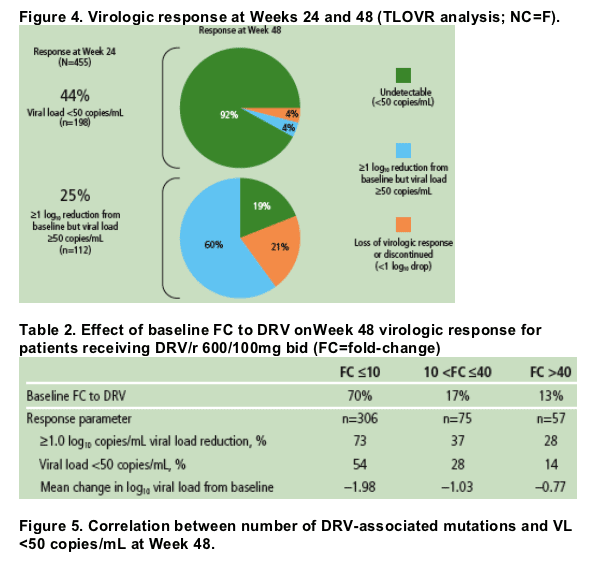
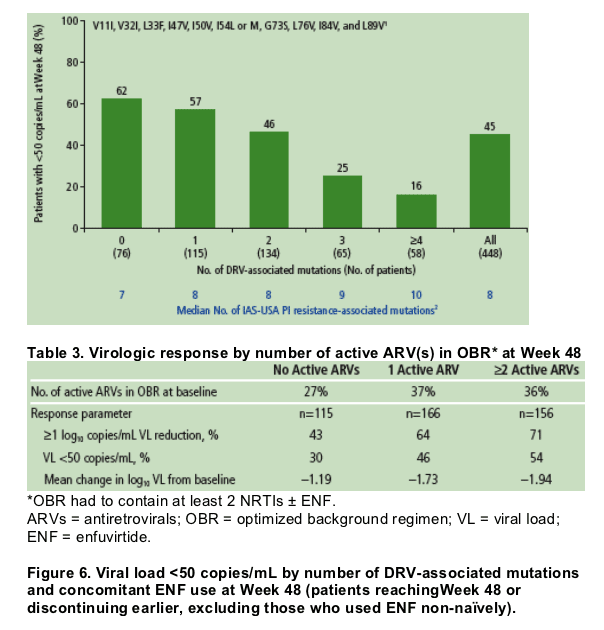
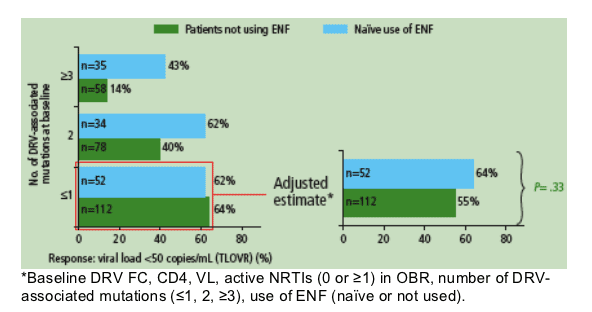
Naive use of ENF in patients with ≦1 DRV-associated mutation at baseline had limited impact on the probability of achieving an undetectable viral load (Figure 6).
- After adjusting for baseline FC to DRV, baseline CD4 count, baseline VL, number of active NRTIs (0 or ≥1) in OBR, number of DRV-associated mutations (≦1, 2, ≥3) and use of ENF, the percent of patients with HIV RNA <50 copies/mL was 55% for non-ENF users and 64% for those using ENF naively.
- Patients receiving ENF naively had a lower mean CD4 count and fewer active NRTIs in their OBR at baseline than patients who did not receive ENF (112 vs 198 cells/mm3, respectively, and 22% vs 41% of patients with ≥2 active NRTIs).
The benefit of using ENF was more evident in patients with 2 or more DRV-associated mutations.
References
1. De Meyer S, et al. Antimicrob Agents Chemother. 2005;49:2314-2321.
2. Hammer S, et al. JAMA. 2006;296: 827-843.
3. DHHS. Guidelines for the use of antiretroviral agents in HIV-1-infected adults and adolescents. October 10, 2006.
http://www.aidsinfo.nih.gov/ContentFiles/AdultandAdolescentGL.pdf.
4. Bellos N, et al. 44th Annual Meeting of the Infectious Diseases Society of America, October 12-15, 2006, Toronto, Canada. Abstract 958.
5. Saag M, et al. 44th Annual Meeting of the Infectious Diseases Society of America, October 12-15, 2006, Toronto, Canada. Abstract 957.
6. Cahn P, et al. 10th European AIDS Conference/EACS, November 17-20, 2005, Dublin, EI. Abstract LBPS3/8.
7. Enfuvirtide prescribing information. Available at http://www.fuzeon.com/pdfs/fpi.pdf.
8. Katlama C, et al. 3rd IAS Conference on HIV Pathogenesis and Treatment, Rio de Janeiro, Brazil; July 24-27, 2005. AbstractWeOaLB0.102.
9. Wilkin T, et al. 45th Interscience Conference on Antimicrobial Agents and Chemotherapy (ICAAC), December 16-19, 2005; Washington, DC, USA. Abstract 2860.
10. Grinsztejn B, et al. 3rd IAS Conference on HIV Pathogenesis and Treatment; Rio de Janeiro, Brazil; July 24-27, 2005. AbstractWePeLB6.201.
11. Berger D, et al. 45th Interscience Conference on Antimicrobial Agents and Chemotherapy (ICAAC), December 16-19, 2005; Washington, DC, USA. Abstract H-1094.
12. Johnson VA, et al. Top HIV Med. 2003;11:215-221.
13. Johnson VA, et al. Top HIV Med. 2004;12:119-124.
14. De Meyer, Sr, et al. XV International HIV Drug ResistanceWorkshop June 13-17, 2006. Oral Presentation and Poster 73.
|
|
| |
| |
|
|
|